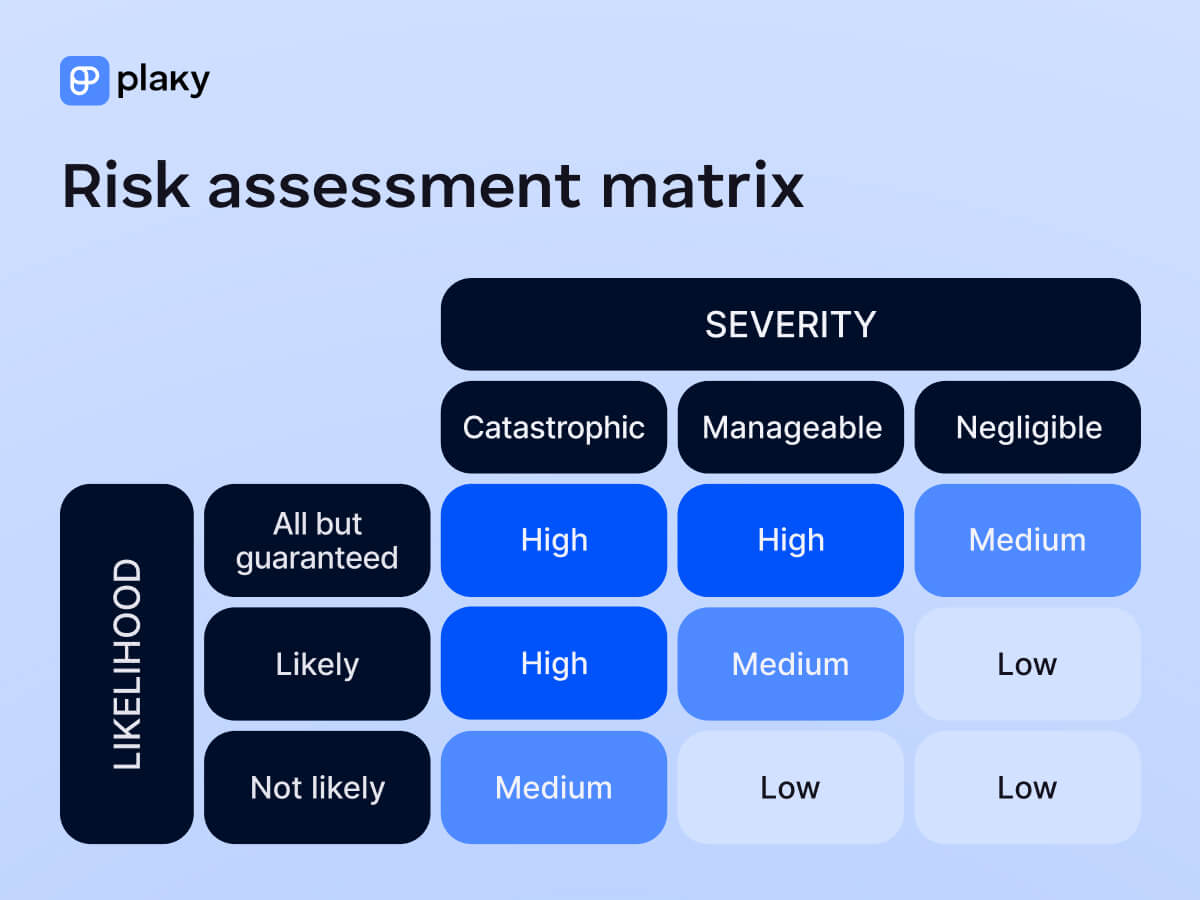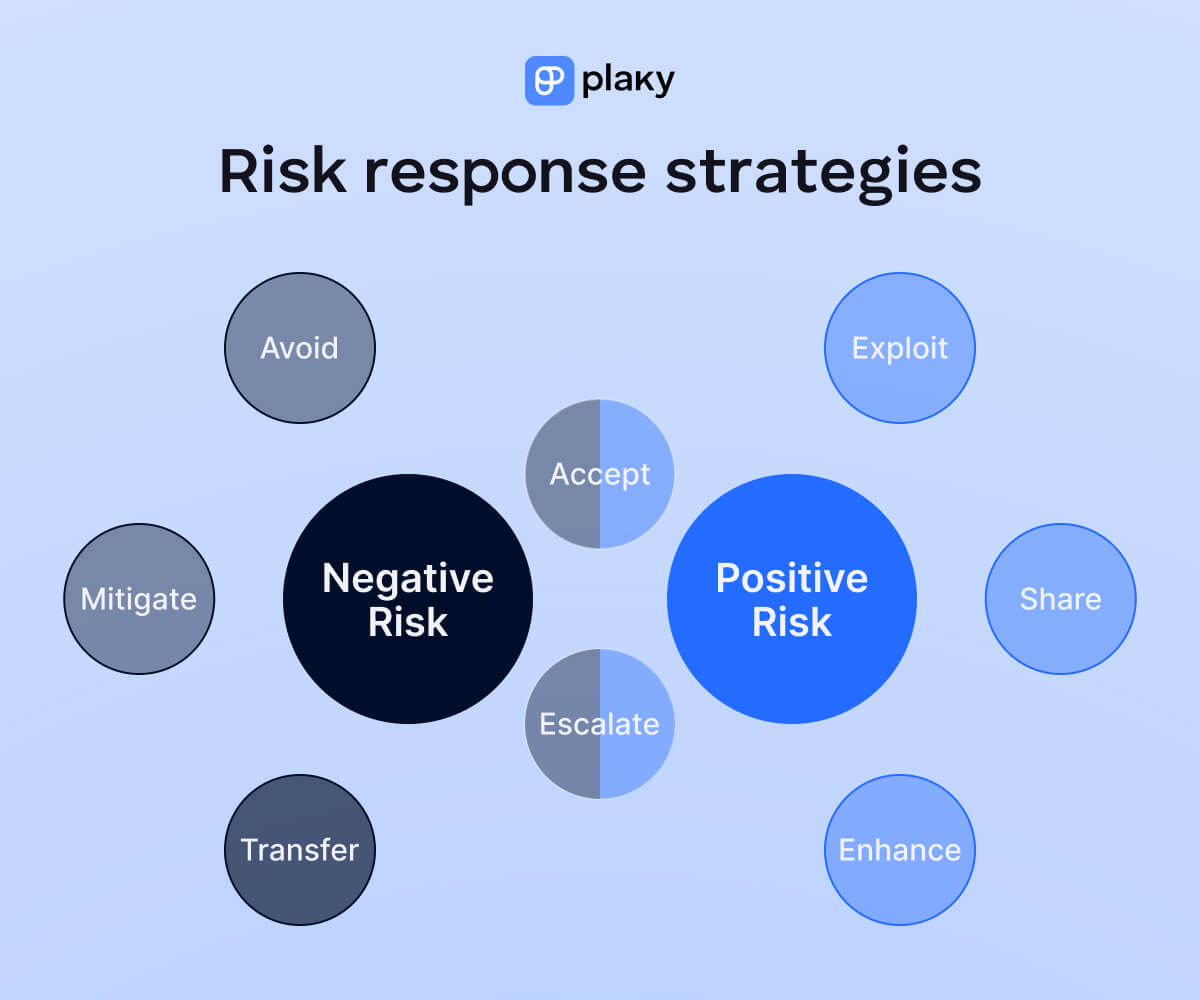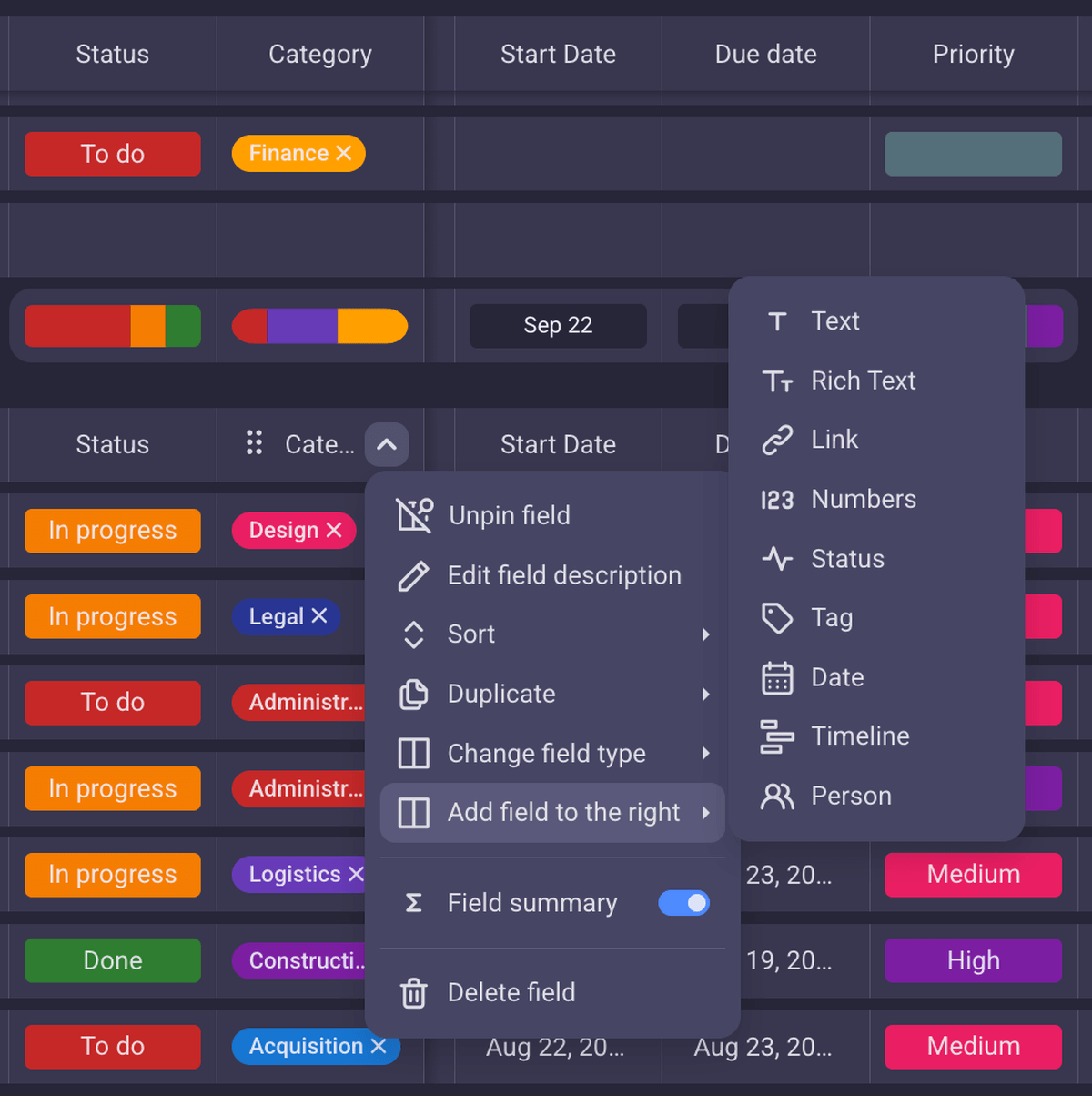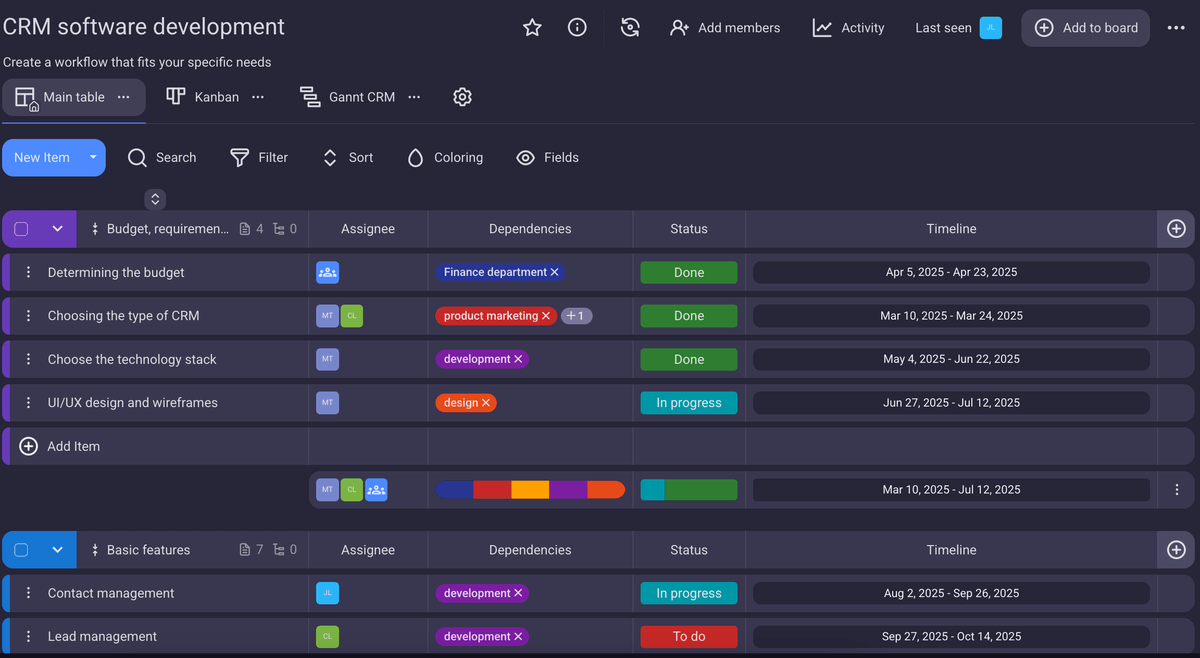Managing project risks is an essential part of project management that maximizes the chances of project success.
Risks are inevitable in every industry, but that doesn’t mean they’re impossible to manage.
How do project managers know what to expect and how to deal with uncertainties? Discover how to manage risks in 6 steps and lend an ear to some of our experts’ advice.

- Project risk management is the process of identifying, analyzing, responding to, and monitoring project risks.
- Project managers should keep tracking risks throughout the project, no matter if they’re positive or negative.
- Having a strong risk management plan helps prevent negative risks, deal with issues, and take advantage of positive risks.
- Strategies for dealing with threats include avoiding, escalating, transferring, mitigating, and accepting the risks.
What is risk management in project management?
Risk management is the process of identifying, analyzing, responding to, and monitoring risks over the course of a project.
The term project risk refers to both opportunities and threats. Opportunities are positive risks, and threats are negative risks. Meanwhile, a negative risk that has already occurred is called an issue.
Types of risk in project management
We can categorize risks in project management into 4 main types:
- Organizational — Mismanaging elements of day-to-day business operations, such as processes, staff, and resources, can pose a risk to the company’s projects and products.
- Financial — Costs are one of the main project constraints, and they can get out of control easily. Managers must keep an eye on the budget and schedule as any delays can cause additional costs and project failure.
- Technical — The hardware and software that the teams use during the project must be functional so that no issues hinder the project’s development.
- External — Market fluctuations, competitor’s activities, and government regulations can greatly influence the project’s course, so they have to be monitored constantly.
💡 Plaky Pro Tip
The latest data shows that a significant 34% of project managers don’t implement risk management in their projects. Check out the latest numbers here:
Why is risk management important in project management?
Project risk management is an important process as it helps you:
- Anticipate and manage change,
- Improve your decision-making,
- Implement lower-cost preventive actions instead of higher-cost reactions to issues,
- Increase the chances of realizing opportunities,
- Raise awareness of the uncertainty of outcomes,
- Improve resilience, and more.
Instead of simply predicting possible outcomes, project risk management aims to develop the means to achieve project objectives.
Our collaborator, Tres Roeder, the PMP, PMI-ACP-certified founder of Roeder Consulting, claims that risk management should be performed both before starting a project and throughout the project:

“At the early stages, risk management will help the team identify and understand the variable forces that will impact the project. It’s more important to understand the project’s sensitivity to each of these risks than it is to perfectly predict the exact timing or magnitude of the risk.
If the risk could be predicted, after all, then it would not be a risk at all and would simply be added to the project plan. During project execution, it is important to re-evaluate the risk picture on a regular and ongoing basis. Things change.”
6 key risk management steps
You can successfully manage risks in any type of project by following these 6 steps:
- Identify,
- Analyze,
- Prioritize,
- Assign risk owners,
- Respond, and
- Monitor risks.
Let’s dive deeper into each step.

#1 Identify risks
Identifying risks usually starts with brainstorming possible risks. This process should include:
- Your project team,
- Stakeholders, and
- Outside experts.
You can include all the identified risks in a risk register — a document used for tracking all potential risks for an ongoing project.

💡 Plaky Pro Tip
Project risks are often confused with project assumptions — read this blog post to learn the difference:
#2 Analyze risks
Once the risks are identified, it’s time to analyze them in a qualitative and quantitative way to understand individual risks better.
Qualitative analysis evaluates various characteristics, such as:
- The severity of the impact on the objectives,
- Manageability,
- Timing of possible impact,
- Relationship with other risks,
- Likelihood of risks occurring, etc.
Qualitative analysis is often represented in the form of a table known as the risk assessment matrix.
The risk assessment matrix evaluates the degree of risk likelihood and severity. The more potential risks your project suffers from, the greater the benefits of creating a comprehensive risk assessment matrix. Regardless of the size of the matrix, once you have it, you can determine where each risk slots into.
Assess each risk’s level for your upcoming project with our customizable template:
Get our risk assessment template

While qualitative analysis mostly relies on guesswork, quantitative analysis takes a much more scientific approach to risk analysis. It uses empirical data to make accurate predictions related to the severity of the impact of certain risks.
The biggest advantage of quantitative risk analysis is that you can get tangible, numerical answers to different questions, e.g., how much a certain risk will affect the:
- Project budget,
- Project timeline,
- Project scope, or
- Project resources.
The downsides to quantitative analysis are that it requires extensive data collection and is challenging to do.
Acquiring the data is easily done when your current project shares similarities with previous projects. But if you’re embarking on a project that is unlike anything the company has ever done before, then you won’t have enough data to do proper quantitative analysis.
In addition, quantitative data analysis is complex, and it often demands using specific software to compute. If something requires twice the effort but only yields a 10% improvement, then it’s simply not worth the effort in most cases.
This is why most managers opt for qualitative analysis only and avoid quantitative analysis.
#3 Prioritize risks
When prioritizing risks, keep in mind the following concepts:
- Risk appetite — the amount of risk an organization is willing to expose itself to in pursuit of its goals. An organization that is unwilling to take any risks is unable to grow, whereas one that takes all risks recklessly is doomed to fail.
- Risk tolerance — the uppermost limit of a company’s risk appetite.
- Risk threshold — the level of risk exposure that spurs the organization into action. Risks below the threshold are, in most cases, simply accepted. When a risk crosses the threshold, it must be addressed.
#4 Assign risk owners
At the end of the day, the project manager is the one bearing accountability for the project as a whole. However, more often than not, they aren’t the ones actively monitoring all potential risks. Instead, they assign risks to different team members.
In most cases, team members have risks assigned to them based on their project roles and responsibilities.
By assigning risks to team members, project managers can focus on more pressing matters while keeping a fresh pair of eyes on the status of each risk.
This way, the team can also assume a more proactive approach toward project completion.
#5 Respond to risks
Whether you use qualitative or quantitative analysis to determine the risks’ threat levels and prioritize them, you need to create a response plan for each. How detailed the plan is will depend on the risks and projects in question.
It’s also helpful to determine what constitutes the risk trigger for each risk — an indicator that a potential risk has either turned into an issue or is about to.
Risks that score higher on the risk assessment matrix naturally warrant more detailed response plans, but this is ultimately the choice of the project manager in charge.
The main point of having a risk management plan is to allow the team to assume a proactive approach toward:
- Preventing negative risks,
- Dealing with issues that could not be prevented, and
- Capitalizing on positive risks.
#6 Monitor risks
Monitoring risks is an ongoing process that spans the entire project timeline.
It allows the project management team to:
- Reevaluate the status of the previously identified risks,
- Identify any secondary risks, and
- Determine the need for reassessment.
At the end of the project, the periodic audit findings should help identify lessons learned for all future projects regarding:
- Appropriate levels of resources,
- The time needed for the analysis,
- Use of tools,
- Level of detail, etc.
💡 Plaky Pro Tip
Like tracking risks in Excel? Check out our Excel risk management template in the post below and tailor it to your liking:
Negative risk management strategies
There are 5 possible responses to negative risks, i.e., threats:
- Avoid — In many cases, avoiding the risk means shutting the project down because it exceeds the company’s risk tolerance.
- Escalate — Escalation is appropriate when a certain threat is outside the project scope or the proposed response exceeds the project manager’s authority. In such cases, threats are escalated to the appropriate level (the enterprise, portfolio, or program level).
- Transfer — Transferring the risk is a response plan that seeks to mitigate risks stemming from third parties by using contractual obligations, insurance, guarantees, or penalties.
- Mitigate — Risk mitigation strategy refers to taking precautions to minimize the probability of risks that can’t be transferred.
- Accept — For risks that rank low on the risk assessment matrix, accepting them is sometimes the only response. It entails doing nothing to minimize the chances of the risk happening. There are 2 types of risk acceptance: active risk acceptance (taking actions to minimize the impact of risks) and passive risk acceptance (taking no actions aside from documentation).

Positive risk management strategies
Positive risks — i.e., opportunities — can be managed in 5 ways:
- Exploit — Try to bring the likelihood of the risk occurring as close to 100% as possible. E.g., if the positive risk is a substantial bonus for completing the project early, exploiting the risk may mean diverting other resources into this project.
- Escalate — Escalate the opportunity to the level that matches the objectives that would be affected if the opportunity occurred.
- Enhance — Try to increase the likelihood of the risk occurring — but don’t pursue it to an exploitative extent. E.g., motivating the team to put in some extra work with a bonus increases your chances of positive risk occurrence, but it’s far from a guarantee.
- Share — Sharing the risk entails involving a third party, usually because you are unable to seize the opportunity alone. A common example includes companies partnering to bid for a project they would otherwise be unable to land.
- Accept — Accepting the positive risk simply means acknowledging it, but not making any effort to increase its chances of happening. If it happens, great; if not, no harm done.
Tips on managing and reducing risks in project management
Now that you’ve mastered project risk management, it’s time to share some valuable advice from experts who have some real-life experience with managing risks.
Tip #1: Manage risks from the start of the project
Our collaborator, Jeff Mains, a 5-time entrepreneur and the CEO of Champion Leadership Group LLC, highlights how risk management is essential to the achievement of both project and business goals.
Jeff advises implementing risk management into your project early on:

“First and foremost, project planning should include risk management. Early risk identification, impact assessment, and mitigation techniques are crucial. This proactive approach manages risks from the start of the project.
Project managers should also review the risk management plan during the project. Staying watchful is essential since risks might change.”
Tip #2: Raise risk awareness within the project team
Jeff also highlights the importance of joint team efforts in managing project risks:

“I also emphasize risk awareness in the project team. Project managers should encourage team members to report risks without repercussions. This collaborative approach helps identify risks early and fosters risk management responsibility.
For project success and corporate resilience, risk management should be an ongoing effort.”
💡 Plaky Pro Tip
Risk management is one of the most important project management hard skills to master. Find out how to become the best project manager here:
Tip #3: Don’t neglect the positive risks
Tres Roeder reminds us that you shouldn’t neglect the positive risks to fully understand the whole picture:

“It is important, of course, to be aware of “negative risks” and to develop plans to prevent them from happening in the first place, or to mitigate their impact if and when they do happen.
However, project managers should also think about the good things that can happen to their project.
These ‘positive risks’ improve project outcomes if they occur. Positive risks should be identified and planned for, too. Only through a comprehensive understanding of both negative and positive risk will the project manager be positioned for success.”
📖 Now that you what risk management is, you can dive further into the topic of project management — check out our Project Management Glossary of Terms and get acquainted with project management terminology.
Manage your project risks with Plaky
The projects that effectively account for all risks are those most likely to succeed. Luckily, a dedicated project management tool like Plaky can help you easily manage your project risks.
In Plaky, you can get a clear overview of all your project tasks and the team’s activities in boards and react fast whenever something isn’t developing as planned.
For instance, since costs and deadlines are crucial parameters for tracking project progress and avoiding risks, you can customize fields to keep an eye on the most important information every day.

Lacking communication and active collaboration leads to a rise of negative risks too. But, in Plaky, the comments section of each item lets you communicate with your team and share updates and thoughts regularly and in real time.

Bottom line? When you have all your project information in one place, mitigating risks becomes easy — and project success entirely attainable.
Improve your risk management. Try out all Plaky features with a 14-day free trial!
How we reviewed this post: Our writers & editors monitor the posts and update them when new information becomes available, to keep them fresh and relevant.

